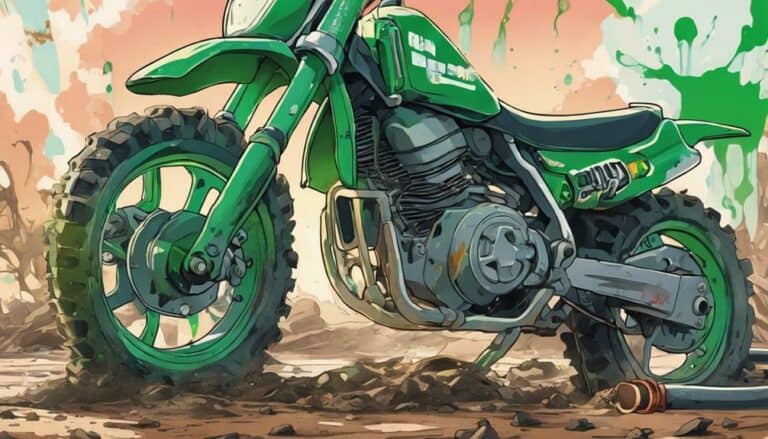When you rev up your dirt bike, the thrill of the ride is unmatched. But what dampens that excitement? A mysterious coolant leak.
You notice the telltale signs, a puddle forming beneath your bike, and your mind races to uncover the culprit. Before you panic, consider this – understanding the root cause of your coolant leak can save you from costly repairs and guarantee your bike's performance stays excellent.
So, let's unravel the mystery together and get your dirt bike back on track.
Key Takeaways
- Leaking radiator hose or swollen hose can cause coolant leaks.
- Water pump or weep hole leaks signal seal failure.
- Radiator overflow and radiator leaks indicate system issues.
- Regular maintenance is crucial to prevent and address coolant leaks promptly.
Leaking Radiator Hose
If you notice your dirt bike leaking coolant, the first important culprit to investigate is a leaking radiator hose. The radiator hose plays a critical role in the cooling system, carrying coolant to and from the radiator. A leaking radiator hose can lead to a loss of coolant, causing your engine to overheat and potentially suffer damage.
Common causes of radiator hose leaks include damage from crashes or wear over time. One of the visible signs of a leaking hose is coolant dripping from the hose itself or pooling underneath the bike. Additionally, a failing hose clamp can also result in coolant leaks. It's essential to inspect the radiator hose thoroughly to pinpoint the source of the leak accurately.
When addressing a leaking radiator hose, consider using a Clamp Kit or Radiator Hose Kit for repairs. Replacing the damaged hose with a new one can effectively resolve the issue and prevent further coolant loss. By promptly addressing a leaking radiator hose, you can maintain the proper functioning of your dirt bike's cooling system and avoid potential engine damage.
Swollen Radiator Hose
A common issue that can arise in dirt bikes' cooling systems is the occurrence of swollen radiator hoses. Swollen hoses are often a result of cooling system clogs or incorrect coolant. It's important to address swollen hoses promptly to prevent potential accidents and further damage to the bike.
Several factors can contribute to hose swelling, including a stuck thermostat or a faulty radiator cap. If you notice swollen hoses, it may be necessary to flush or replace the radiator to resolve the issue effectively. Utilizing a Clamp Kit or Radiator Hose Kit can assist in repairing swollen radiator hoses efficiently.
Regular maintenance of your dirt bike's cooling system, such as checking the radiator cap and thermostat, can help prevent the occurrence of swollen hoses. If you suspect an issue with your bike's cooling system, consider performing a radiator flush to ensure peak performance and prevent further complications.
Water Pump or Weep Hole Leak
Experiencing coolant leakage from the weep hole on your dirt bike typically signals a water pump seal failure. The weep hole is designed to allow coolant to escape when the seal between the impeller shaft and the water pump housing deteriorates. To better understand this issue, consider checking the impeller shaft for wear or grooves, as these can contribute to leaks. When faced with a water pump or weep hole leak, inspect the water pump cover for signs of leakage to confirm the source of the problem. Utilizing a Water Pump Rebuild Kit is a practical solution to address this type of leak efficiently.
| Water Pump or Weep Hole Leak | |
|---|---|
| Causes | Water pump seal failure |
| Inspection | Check impeller shaft for wear or grooves |
| Solution | Utilize Water Pump Rebuild Kit |
Radiator Overflow Leak
Leaking coolant from the weep hole due to a water pump seal failure can sometimes lead to radiator overflow leaks caused by excessive pressure in the cooling system. When the cooling system is under high pressure, it can overwhelm the radiator cap's ability to maintain the correct pressure levels, resulting in coolant being forced out through the overflow tube. This overflow of coolant is a clear indicator of a problem within the system that needs immediate attention.
To address a radiator overflow leak, start by checking the radiator cap for any signs of damage or wear. A faulty radiator cap can fail to regulate the pressure effectively, leading to coolant leaks. Additionally, inspect the overflow tube for any blockages that may be impeding the proper flow of coolant.
Regular maintenance practices, such as monitoring coolant levels and ensuring the proper functioning of the water pump, are essential in preventing radiator overflow leaks. By staying proactive with maintenance, you can avoid potential damage to your dirt bike caused by coolant leaks.
Radiator Leak
Identifying the source of a radiator leak on your dirt bike is important for maintaining top engine cooling performance and preventing potential damage. When your radiator is leaking, it can be a sign of underlying issues in your coolant system.
Here's how you can tackle this problem effectively:
- Check for Damage: Inspect your radiator for any signs of physical damage, especially after crashes or impacts.
- Examine Hoses and Connections: Look closely at the radiator hoses and connections for any leaks or wear that may be causing coolant to escape.
- Pressure Test the System: Conduct a pressure test on the coolant system to pinpoint the exact location of the leak.
- Consider Corrosion: Keep in mind that corrosion can also be a culprit behind radiator leaks, especially in older bikes.
Conclusion
If your dirt bike is leaking coolant, don't ignore it. Address the issue promptly to prevent further damage. Did you know that a small radiator hose leak can result in a loss of up to 1 gallon of coolant per hour?
Imagine that amount of liquid seeping out of your bike while you ride. Stay on top of maintenance to keep your dirt bike running smoothly and avoid costly repairs in the future.

